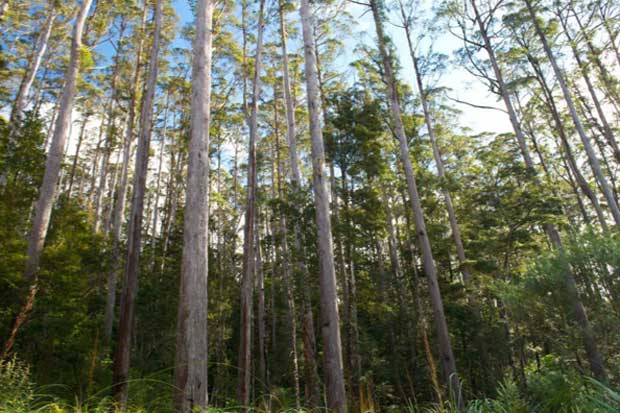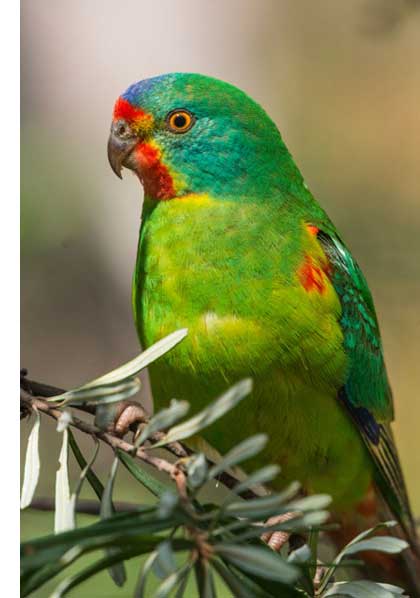Tasmanian Authorities have again been called out for failing to protect the endangered Swift Parrot, with three prominent environment groups yesterday slamming Forestry Tasmania for disregarding scientific warnings to make way for the logging of its last sanctuary.
Even as the government corporation seeks to be certified as a sustainable forester, it is reportedly fishing for a green group that will give wings to its plans to log in contravention of scientific evidence.
The outcry follows an earlier debacle, exposed by Environment Tasmania late last month, which revealed the Tasmanian Department of Primary Industries, Parks, Water and Environment ignored its own scientists’ expert advice and forged ahead with the logging of key breeding habitat.
Loss of breeding habitat is acknowledged as the major threat to Swift Parrot survival, and scientists, including the Tasmanian government’s own, say we just can’t afford to destroy any more.
On Thursday, the Tasmanian Conservation Trust, Markets for Change, and the Bob Brown Foundation slammed Forestry Tasmania, accusing it of trying to ‘ambush’ green groups into backing its plans to continue the logging of breeding habitat.
At least five major environment groups active in Tasmania say that if Forestry Tasmania received certification from the Forestry Stewardship Council, a recognised international body, it would effectively condone an organisation which is driving the bird to extinction.
After a study from scientists at the Australian National University predicted the species will decline by 95 per cent in three generations, or 16 years, a recommendation that the bird be listed as critically endangered is currently being considered by the federal government.

The study forecast that numbers will halve every four years, and the researchers called for a moratorium on logging. It is thought that less than 2,500 Swift Parrots survive in the wild.
The small, colourful bird, migrates from the mainland each year to breed in Tasmania. It’s the longest known migration of any parrot, but continued logging of Tasmania’s old-growth forests has seen the unique bird, which is also Australia’s fastest-flying nectar-eater, winging its way rapidly towards extinction.
Last year, a separate study broke new ground when it discovered yet another threat – Sugar Gliders.
According to the study on Sugar Glider predation, just 17 per cent of Swift Parrot nests survive the 60-day breeding period on Tasmania’s mainland, and logging exacerbates the threat by thinning the canopy.
But there is one place where the Sugar Gliders haven’t reached – Bruny island, off the southern tip of Tasmania. It’s a sanctuary Forestry Tasmania is already logging, and plans to log further.
Conservation groups say that’s a death warrant for the Swift Parrot, which the study found had 100 per cent breeding success on Bruny Island, away from Sugar Glider Predation.
And the impotent efforts of Tasmanian authorities to save the species are not just bad for the bird. For years Forestry Tasmania has been trying to get the green light from the Forest Stewardship Council, which would certify its products as meeting key environmental standards.
This green credit would give the loss-making Tasmanian forestry industry a much-needed boost, as retailers and consumers increasingly look for ethical and sustainable timber products.
“Forestry Tasmania has not actually been prepared to confront the enormity of the change they need to make in their operations if they want to get FSC certification,” CEO of Markets For Change Pegg Putt said.
“They’ve tried to greenwash over their deficiencies.”
In fact, Forestry Tasmania appears to be shopping around looking for an environment group that will help them get certification.
“It’s quite manipulative – what we’ve described as an ambush tactic,” Peter McGlone, Director of the Tasmanian Conservation Trust, told New Matilda.

“The way they’re trying to deal with it is they’re ringing up some conservation groups, not ringing up other conservation groups.” The reality is, though, that further logging of breeding habitat will badly undermine the species’ chance of survival.
“They’re really trying to get people who will support something that will support their management approach,” McGlone said.
The Tasmanian Conservation Trust and at least one other group have been approached, environmentalists suspect that Forestry Tasmania has also tried to attract the support of key scientists, and that other meetings are in the offing.
The Tasmanian Conservation Trust, Markets for Change, and the Bob Brown foundation last year made a jointly prepared submission to the auditors who will decide whether to grant Forestry Tasmania certification, a copy of which has been obtained by New Matilda.
The bid for final certification has been pushed back by a month, they say, as Forestry Tasmania works to address issues identified in a draft audit.
“Stakeholder feedback plays a massive part in the certification process,” a spokesperson for the Forestry Stewardship Council assured New Matilda, but the groups that will largely inform the auditor’s decision are far from impressed.
"We understand that Swift Parrot conservation is one of the [eight]issues of non-compliance found by auditors SCS Global,” McGlone said.
“We must have this confirmed by Forestry Tasmania and know the context prior to meeting, especially the relevance of our input to any FSC certification.”
The groups say that no level of logging of Swift Parrot habitat is acceptable and that they have notified FSC of the “serious adverse impact” logging on Bruny Island will have, impacts which it says “contravene several key principles and criteria of FSC”.
Another Bruny Island coupe is due to be logged beginning in October, a move which has been roundly condemned.
A spokesperson for Environment Tasmania said all logging of breeding habitat should cease, describing the logging on Bruny Island as “particularly insidious”.
“To even be considering it just seems reckless in the extreme,” he said.
The Wilderness Society said it agrees with Environment Tasmania’s position.
“If they were in any way serious about their commitment to protecting Swift Parrots they would immediately halt all logging of Swift Parrot habitat on Bruny island and for them not to do so is just atrocious,” a spokesperson for Birdlife Australia said.
Earlier this year, Birdlife Australia wrote to the auditor, identifying a number of issues of non-compliance with FSC standards and adding its voice to the chorus of organisations recommending against certification in the absence of better plans.
The interim plan Forestry Tasmania has submitted to the auditors “maliciously misconstrues the criteria they were meant to address,” according to the Tasmanian Conservation Trust.
The plan fails to recognise large areas of known Swift Parrot breeding habitat, including Bruny Island.
“It’s like doing an exam question where you re-write the question then go on to write an answer that’s really simple to write,” McGlone said.
Further, “Forestry Tasmania have failed to incorporate the results of new scientific information and change their management plan to respond to the new environmental circumstances that have been revealed by research into Sugar Glider predation on Swift Parrot nests,” the joint submission to the auditor said.
Given the fact that the success rate of breeding is 73 per cent greater on the island, and 83 per cent of adult females were also killed where glider predation was present on the mainland, the submission argues it should be classified as ‘refugia’, which is the highest classification.
Forestry Tasmania declined to be interviewed for this story, but it, and successive governments, have increasingly seen certification as a priority due to the market’s growing desire for sustainable and ethical timber products.
“It’s just very clear that consumers care a lot about endangered species and they don’t want to see products arising from the destruction of the habitat,” Putt said.
“It’s just sort of ‘101 how it works’ in markets these days.”
“Unfortunately we’ve got a government corporation in Forestry Tasmania here that thinks you can somehow green over that.”
A decision on Forestry Tasmania’s FSC bid is expected in May
Donate To New Matilda
New Matilda is a small, independent media outlet. We survive through reader contributions, and never losing a lawsuit. If you got something from this article, giving something back helps us to continue speaking truth to power. Every little bit counts.



